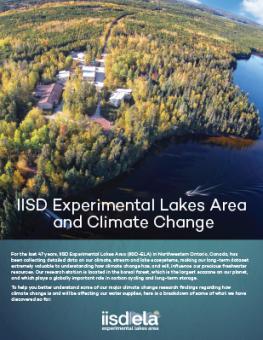
IISD Experimental Lakes Area and Climate Change brochure
IISD Experimental Lakes Area brings a 47 year (1969–present) history of monitoring climate, water quality and fisheries in a unique whole-ecosystem laboratory setting.
IISD Experimental Lakes Area (IISD-ELA) brings a 47 year (1969–present) history of monitoring climate, water quality and fisheries in a unique whole-ecosystem laboratory setting.
Now, as a part of IISD, it has the opportunity to use its long-term monitoring dataset to examine how climate change is affecting boreal forests, wetlands and lakes from a consistent, long-term, whole-ecosystem dataset of significant scientific and societal value.
This brochure presents some of IISD-ELA's major climate change research findings, so you can see the data for yourself and understand how climate change is affecting our lakes.
You might also be interested in
How can we improve on freshwater health and prevent plastic pollution?
INC-4 is the fourth meeting in a series of international negotiations that aims to develop a global treaty on plastic pollution that could and should have big implications for freshwater quality both in Canada and beyond.
National State of the Environment Report: Uzbekistan
The National State of the Environment Report (NSoER) is a comprehensive document that provides a snapshot of current environmental trends in Uzbekistan's socio-economic development for citizens, experts, and policy-makers in the country of Uzbekistan.
Northwest Ontario Side Story: IISD Experimental Lakes Area Annual Report 2022-2023
This year's annual report is a celebration of all things creative at the world's freshwater laboratory, from the science to music, photography and theatre.
The Critical Next Step: What you need to know about Canada’s 2030 climate target
Canada's climate target for 2030 is within reach, but more stringent policies and clearer government communication will be needed to get there. Our expert explains why these developments are critical for Canada to help avoid the worst impacts of climate change.